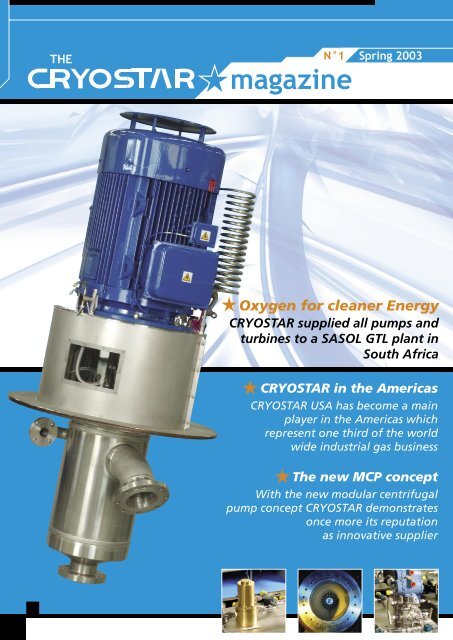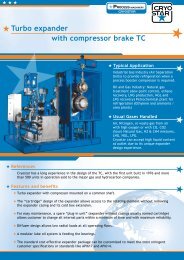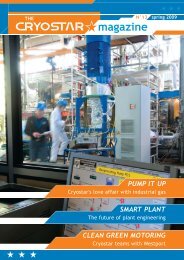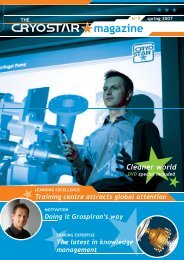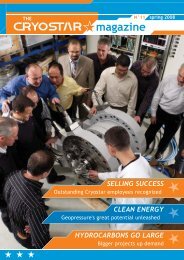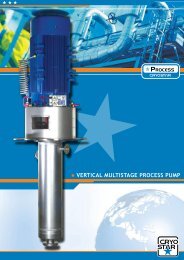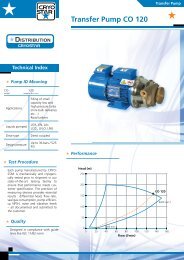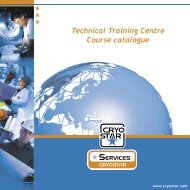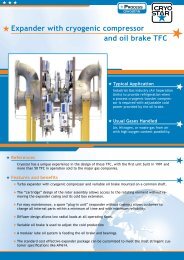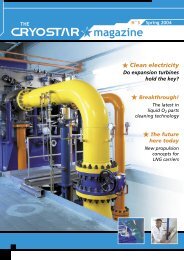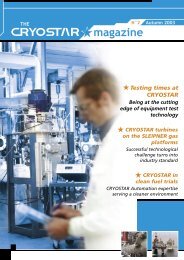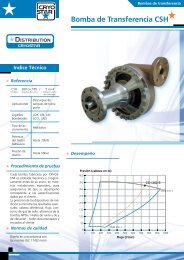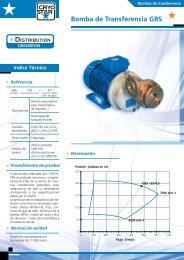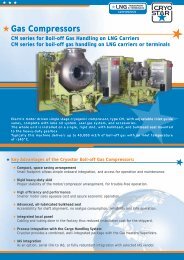Create successful ePaper yourself
Turn your PDF publications into a flip-book with our unique Google optimized e-Paper software.
N°1<br />
Spring 2003<br />
<strong>Oxygen</strong> <strong>for</strong> <strong>cleaner</strong> <strong>Energy</strong><br />
CRYOSTAR supplied all pumps and<br />
turbines to a SASOL GTL plant in<br />
South Africa<br />
CRYOSTAR in the Americas<br />
CRYOSTAR USA has become a main<br />
player in the Americas which<br />
represent one third of the world<br />
wide industrial gas business<br />
The new MCP concept<br />
With the new modular centrifugal<br />
pump concept CRYOSTAR demonstrates<br />
once more its reputation<br />
as innovative supplier
2<br />
Spring 2003<br />
EDITO This is the first issue of the newly created CRYOSTAR magazine aimed<br />
at in<strong>for</strong>ming our customers all over the world.<br />
Twice a year, in Spring and in Autumn, “The CRYOSTAR Magazine”<br />
will in<strong>for</strong>m you about the CRYOSTAR products and their applications,<br />
the constant product developments and other innovations we are bringing<br />
to our respective markets, our worldwide organisation, and our<br />
personnel.<br />
CRYOSTAR is present with operations and business centres in seven<br />
countries on four continents. Our pumps, turbines, cylinder filling stations,<br />
vaporisers, compressors and heat exchangers are installed in many<br />
countries on all five continents. Although our headquarter is located in<br />
France, we feel to be more a “citizen of the world” company as 90 percent<br />
of our products are installed out of France. Not only are we selling into<br />
many countries, but we are also buying parts or components from suppliers<br />
in America, Europe or Asia.<br />
CRYOSTAR is definitely an internationally oriented company dealing<br />
in three main market segments: Industrial gas, LNG equipment<br />
and Hydrocarbon turbines, with customers on all five continents.<br />
CRYOSTAR’s personnel, representing more than twenty different<br />
nationalities, speaking as many languages, are very proud to present you<br />
this first issue of “The CRYOSTAR Magazine”.<br />
<strong>Oxygen</strong> <strong>for</strong> <strong>cleaner</strong> <strong>Energy</strong><br />
New Propulsion Concepts <strong>for</strong> LNG Carriers<br />
CRYOSTAR in the Americas<br />
CRYOSTAR Turbines <strong>for</strong> Processing Industries<br />
News<br />
The new MCP concept<br />
Events<br />
Tools<br />
p 03<br />
p 06<br />
p 07<br />
p 08<br />
p 09<br />
p 10<br />
p 11<br />
p 11<br />
Daniel MEYER<br />
Managing Director
<strong>Oxygen</strong> <strong>for</strong> <strong>cleaner</strong> <strong>Energy</strong><br />
In January 2003, CRYOSTAR delivered a major order <strong>for</strong> expansion turbines and process<br />
pumps to L’Air Liquide, Champigny, France. These machines are required to equip the<br />
largest Air Liquefaction plant ever constructed, which will be built <strong>for</strong> the SASOL<br />
petrochemical company, in South Africa.<br />
H igh<br />
efficiency 500kW<br />
saving 1MW.<br />
CRYOSTAR’s supply included:<br />
> Vertical Multistage Pumps<br />
> Modular Centrifugal Pumps<br />
> Liquid Turbine<br />
> Generator Loaded Turbine<br />
The 3’500 ton/day Air Separation<br />
Unit (ASU) feeds large quantities<br />
of oxygen to the Sasol petrochemical<br />
plant in South Africa.<br />
Our high efficiency gas expansion<br />
turbine, with a cold production<br />
exceeding 500kW, together with<br />
a liquid expansion turbine,<br />
reduces the plant’s overall<br />
power consumption by over<br />
1MW. In addition, high-duty<br />
process pumps further improve<br />
the overall plant efficiency.<br />
These huge volumes of oxygen<br />
are required by Sasol in their<br />
process to convert methane gas<br />
into liquid.<br />
It is interesting to note that two<br />
of CRYOSTAR’s main market<br />
segments - the industrial air gas<br />
and the LNG/hydrocarbon industries<br />
are involved in this project.<br />
CRYOSTAR’s unique product<br />
portfolio allows it to overcome<br />
the challenges of managing energy<br />
in this natural gas process.<br />
V P 4 / 310 / 7L<br />
V P 3 / 310 / 6 , 5 L<br />
M C P 4 0 0 / 2 0 L<br />
M C P 155 / 4 , 5 L<br />
F l ow<br />
1’15 0 l / m i n<br />
75 2 l / m i n<br />
3 ’ 3 70 l / m i n<br />
7 3 l / m i n<br />
Natural gas can be delivered to<br />
the market in two <strong>for</strong>ms : gas or<br />
liquid.<br />
Natural gas currently represents<br />
around 18% of the world energy<br />
supply and is the fastest growing<br />
energy source today.<br />
The energy potential of natural<br />
gas can be delivered to the market<br />
as a gas or a liquid.<br />
For delivery of gas to the market,<br />
three options exist: directly via<br />
pipeline, liquefied natural gas<br />
(LNG) or compressed natural gas<br />
(CNG).<br />
P r e s s u r e<br />
41 b a r a<br />
4 0 b a r a<br />
4 b a r a<br />
3 b a r a<br />
Spring 2003 3
4<br />
OXYGEN FOR CLEANER ENERGY<br />
CRYOSTAR also supplies equipment<br />
<strong>for</strong> the handling of LNG.<br />
Gas liquefied at the production<br />
site, is then transported in large<br />
methane tankers to the consumer<br />
countries. CRYOSTAR equips<br />
these methane vessels with Boiloff<br />
gas compressors, vaporisers<br />
and heaters allowing, them to<br />
feed the vaporised LNG (Boil-off)<br />
to the ships engine, as propulsion<br />
energy.<br />
Let us now consider the second<br />
way to bring natural gas to the<br />
market, liquid product distribution,<br />
which was chosen by Sasol<br />
<strong>for</strong> their Gas-to-liquids (GTL)<br />
technology.<br />
GTL: a high-ranking alternative<br />
to LNG.<br />
First, we have to understand<br />
why GTL technology exists, is<br />
developing, and can be considered<br />
as a strong alternative to regular<br />
LNG and the oil industry.<br />
Natural gas is liquefied using a<br />
physical process, by cooling down<br />
the extracted pressurised gas,<br />
resulting in a cryogenic liquid<br />
(LNG) at a very low temperature<br />
of -160°C (-265°F).<br />
GTL, however, is produced by<br />
a chemical process, and various<br />
methods are used to trans<strong>for</strong>m<br />
GTL Gas to Liquids Process<br />
Spring 2003<br />
the gas into different liquids at<br />
ambient temperature.<br />
Transportation of GTL products,<br />
due to their ambient temperatures,<br />
is much easier than that of very<br />
cold LNG.<br />
The tanks and vessels containing<br />
the GTL liquids do not<br />
require special insulation to avoid<br />
vaporisation, as do those <strong>for</strong><br />
the LNG. There are no product<br />
losses between production and<br />
utilisation. Furthermore, these<br />
GTL liquids can be considered as<br />
final products, such as Gasoline,<br />
Diesel or chemical products like<br />
Ethylene, etc. No additional<br />
refining processes are required in<br />
the consumer countries. A clean<br />
product is imported to the user<br />
country and this has a significant<br />
impact on the reduction of the<br />
pollution normally caused by<br />
refining processes.<br />
Natural gas there<strong>for</strong>e, has a real<br />
future, and will certainly compete<br />
more heavily with oil, which<br />
represents close to 43% of the<br />
current world energy supply.<br />
More about the technology<br />
There are two major GTL<br />
technologies. The so-called<br />
direct GTL, which consists<br />
of Pyrolysis, Clorination and<br />
Oxidative Coupling of methane,<br />
or Direct Oxidation of methane<br />
to methanol. These methods<br />
are still considered very energy<br />
intensive, and are not used in the<br />
Sasol process.<br />
The second technology route has<br />
two options. The first called POX<br />
(Partial Oxidation of LNG) is<br />
used by Shell <strong>for</strong> the Bintulu Plant<br />
in Malaysia, where Air Liquide<br />
also provided the ASU, equipped<br />
with CRYOSTAR machines.<br />
The second option (used by<br />
Sasol) called ATR (Auto Thermal<br />
Re<strong>for</strong>mer), using a steam-re<strong>for</strong>ming<br />
step to create a synthesis gas<br />
CO: H2 (ratio 2-1). Thereafter,<br />
the Fisher-Tropsch (FT) reaction<br />
is used, to trans<strong>for</strong>m the synthesis<br />
gas into paraffinic hydrocarbons.<br />
Current World<br />
<strong>Energy</strong> supply<br />
43%<br />
Coal<br />
Gas<br />
2% 11%<br />
1% 18%<br />
Hydro<br />
Nuclear<br />
25%<br />
Other<br />
Oil
Typically, FT plants produce<br />
about 25% gaseous products.<br />
Part of this is recycled as feed to<br />
the synthesis gas generation. The<br />
propane and butane produced is<br />
liquefied and exported as LPG.<br />
The remaining 75% liquid products<br />
are split into gasoil, kerosene<br />
and tops/naphta. The gasoil is<br />
sold as diesel. Kerosene is used as<br />
aircraft fuel, with the naphta/tops<br />
product being used as feedstock<br />
<strong>for</strong> ethylene plants.<br />
The GTL solution has some<br />
clear advantages concerning<br />
environment protection and the<br />
quality and diversity of the final<br />
products.<br />
LTG 9 0<br />
TG 3 0 0<br />
Transportation of LNG or GTL<br />
Pipelining is generally considered<br />
the cheapest transport option up<br />
to 2’500 km (1’500 miles), except<br />
in case of smaller fields, where onsite<br />
power generation could be a<br />
viable alternative if the conditions<br />
are right. Over 2’500 km (1’500<br />
miles), pipelining can still be an<br />
option, depending on the size<br />
of the gas field and its location.<br />
There may be a case <strong>for</strong> LNG or<br />
GTL. Beyond 4’000 km (2’500<br />
miles), pipelining is no longer a<br />
viable option, and exploiting the<br />
reserve will have to come from<br />
either LNG or GTL.<br />
Despite the fact that GTL is still<br />
slightly more expensive than<br />
LNG, and that the competitiveness<br />
of LNG depends directly on<br />
oil- price levels, it seems that GTL<br />
C o l d p r o d u c t i o n<br />
2 7 3 k W<br />
5 0 3 k W<br />
should be considered as a main<br />
source of energy.<br />
Future developments<br />
The next project <strong>for</strong> a new plant,<br />
which will be built by Qatar<br />
Petroleum and Sasol, confirms<br />
this positive trend.<br />
This new plant, called Oryx GTL<br />
Limited, in northern Qatar, is to<br />
be built by French-based engineering<br />
company, Technip-Coflexip.<br />
The project, which jointly owned<br />
by Qatar Petroleum (51%) and<br />
Sasol (49%), will be operational in<br />
2005. Nearly 10 million m3 of gas<br />
will be used daily to<br />
F l ow up to<br />
13 0 ’ 0 0 0 N m 3 / h<br />
3 0 ’ 0 0 0 N m 3 / h<br />
produce 34’000 barrels of oil products<br />
<strong>for</strong> the chemical industry.<br />
OXYGEN FOR CLEANER ENERGY<br />
Qatar has the world’s third<br />
largest gas reserves, after Russia<br />
and Iran.<br />
The markets that could absorb<br />
those products are Singapore,<br />
Japan and Europe.<br />
The ASU needed to fulfil the oxygen<br />
requirements <strong>for</strong> the plant,<br />
will be double the size of the first<br />
one <strong>for</strong> Sasol South Africa, with a<br />
daily production of 7’000 tons.<br />
These mega-projects represent<br />
a challenging new opportunity<br />
<strong>for</strong> CRYOSTAR to show<br />
its expertise and competence in<br />
providing the required special<br />
turbines and pumps.<br />
Two additional projects are under<br />
discussion <strong>for</strong> other major players<br />
in the GTL field - one <strong>for</strong> Shell requiring<br />
a 15’000 t/day ASU, and<br />
one <strong>for</strong> Exxon with a 20’000 t/<br />
day ASU.<br />
Spring 2003 5
6<br />
CUSTOMERS<br />
New Propulsion Concepts<br />
<strong>for</strong> LNG Carriers<br />
Boil-off gas Principle<br />
Over large distances Natural Gas<br />
is transported in liquid state by using<br />
LNG Carriers. Since Liquefied<br />
Natural Gas (LNG) is transported<br />
and stored at a temperature of<br />
around -160°C, the heat creeping<br />
through the insulation always<br />
leads to a continuous boil-off of<br />
the LNG during transportation.<br />
Accordingly, equipment needs<br />
to be provided to handle this<br />
continuous boil-off.<br />
Steam Propulsion:<br />
The Current Concept<br />
As of today, the boiled-off natural<br />
gas was always used <strong>for</strong> the ship’s<br />
propulsion: Low-duty compressors<br />
bring the natural gas to the<br />
boiler, steam is generated, and<br />
used in a steam turbine.<br />
Cargo Handling System<br />
The Cargo Handling System assures<br />
safe operation of the vessel<br />
by treating the natural gas and<br />
LNG during all operating phases<br />
of a vessel. During the voyage, one<br />
of the two Low-duty Compressors<br />
(cryogenic single stage blowers)<br />
keeps the tank pressure within an<br />
acceptable limit, by bringing the<br />
natural gas to the boiler.<br />
Efficiency and Operation<br />
Aspects<br />
With improved insulation<br />
techniques the reduced natural<br />
boil-off however is not enough<br />
to satisfy the speed requirement<br />
<strong>for</strong> an economic operation. Additional<br />
fuel is required, which is<br />
Spring 2003<br />
usually bunker oil, or additional<br />
natural gas that is gained on the<br />
vessel by a ‘<strong>for</strong>ced’ vaporization.<br />
Each such additional gas means<br />
extra operating cost, which<br />
can be reduced by improving<br />
the efficiency of the propulsion<br />
system. For steam propulsion<br />
the overall efficiency is not more<br />
than around 30%. With modern<br />
propulsion systems however, the<br />
overall efficiency can be lifted to<br />
some 40%, which means 25%<br />
fuel saving.<br />
New Propulsion Systems<br />
The new propulsion systems which<br />
are being studied have in common,<br />
that a reliable, safe and economic<br />
solution must be found to use the<br />
inevitable boil-off gas.<br />
Chantiers de l’Atlantique, the reputed<br />
French shipyard is currently<br />
building the first LNG Carrier<br />
with Diesel-electric propulsion.<br />
Considering the higher feed pressure<br />
to the dual fuel engine the<br />
Low-duty Compressors are here of<br />
a 2-stage design. These machines<br />
<strong>for</strong> the first vessel are on order at<br />
CRYOSTAR, and will be tested<br />
and delivered in autumn 2003.<br />
Other shipyards put an emphasis<br />
on Gas Turbine Propulsion. The<br />
need of a feed pressure between<br />
20 and 30 bar however calls <strong>for</strong><br />
an innovative solution <strong>for</strong> the<br />
required cryogenic compressor,<br />
that CRYOSTAR will<br />
present shortly.<br />
Most of the vessels of the world<br />
fleet use a low-speed Diesel engine<br />
as propulsion.<br />
As the fuel injection pressure is<br />
around 250 bar however, there is<br />
no economic solution <strong>for</strong> feeding<br />
the boil-off gas to this type of<br />
engine and the tank pressure must<br />
be controlled by re-liquefaction of<br />
the boil-off gas.<br />
Already involved in a re-liquefaction<br />
project in the mid-eighties,<br />
CRYOSTAR recently developed<br />
the Re-liquefaction Plant ‚<br />
EcoRel’. This unique solution assures<br />
full re-liquefaction without<br />
venting a methane/nitrogen<br />
mixture to the atmosphere.<br />
There<strong>for</strong>e, ‘EcoRel’ is not only<br />
an economic solution, but also<br />
satisfies the most demanding<br />
ecological criteria.<br />
Design Optimization<br />
Operating Envelope<br />
In designing adequate machinery,<br />
CRYOSTAR takes utmost care of<br />
providing an as-wide-as-possible<br />
operating envelope, to allow a<br />
reliable and safe operation under<br />
all operating conditions of the<br />
vessel. CRYOSTAR is reputed to<br />
use their outstanding experience<br />
and expertise <strong>for</strong> an extensive<br />
support of shipyards, ship owners<br />
and operators <strong>for</strong> an enhanced<br />
operation. And CRYOSTAR<br />
has the right solution available<br />
whatever propulsion system will<br />
be selected <strong>for</strong> a specific project.
CRYOSTAR in the Americas<br />
T he<br />
recent acquisitions of the CCI and CVI<br />
pump lines have further diversified CRYO-<br />
STAR’s offerings adding seven different pump<br />
types as well as their associated various stroke<br />
combinations. There<strong>for</strong>e CRYOSTAR USA is<br />
in a position to respond to most of the customers’<br />
needs in terms of process, transfer or distribution<br />
pumps as well as turbines <strong>for</strong> industrial<br />
gas applications. Also we have developed<br />
a service and maintenance concept <strong>for</strong> all types<br />
of pumps including competitors products.<br />
CRYOSTAR USA today counts close to 20 employees<br />
and manufactures locally all models of piston pumps<br />
as well as CSH/CSJ 260 - 10” centrifugal trailor<br />
pumps. We supply not only the North and South<br />
American markets but also the Asia/Pacific Rim as a<br />
source <strong>for</strong> piston pumps <strong>for</strong> CRYOSTAR Singapore.<br />
Our manufacturing facility in Santa Fe Springs is<br />
equipped with a nitrogen test stand as well as a clean<br />
room.<br />
BUSINESS CENTRES<br />
I n t hree ye a r s t i m e , C RYOSTA R U S A h a s s i g nificantly g r ow n a s a r e s u l t of<br />
a n a g g r e s s i ve s a l e s a n d s e r v i c e s t rategy c o m b i n e d w i t h t wo a c q u i s i t i o n s .<br />
I d e a lly p o s i t i o n e d o n t h e E a s t a n d We s t C o a s t of t h e U S , C RYOSTA R U S A i s<br />
c ove r i n g N o r t h , C e ntral and South America.<br />
With two US locations:<br />
> Manufacturing and Service on the West coast, in Santa Fe Springs, Ca<br />
> Sales and Service in the East, in Whitehall, Pa<br />
CRYOSTAR USA is ideally positioned to well serve our customers in the area.<br />
CRYOSTAR USA promotes and sells a unique lease<br />
program that enables <strong>for</strong> virtually trouble-free and<br />
totally expected and planned pump operation. This<br />
arrangement, spread over a period of 5 years, consists<br />
of a new concept of leasing <strong>for</strong> this type of equipment.<br />
During this period of time, all maintenance will be<br />
taken care of by the manufacturer on a preventive<br />
schedule basis thus enabling the operator to totally<br />
<strong>for</strong>ecast the maintenance intervals <strong>for</strong> a monthly,<br />
fixed all-inclusive price. Not to mention this program<br />
includes a 5-year warranty on the pump and we keep<br />
a complete inventory of foot-mounted pumps in stock<br />
to sustain the program. At the end of the 5 year lease,<br />
the pump is yours <strong>for</strong> US$ 1.<br />
CRYOSTAR USA is now the second largest CRYO-<br />
STAR business unit with plans to further grow.<br />
Spring 2003 7
8<br />
TECHNICAL<br />
CRYOSTAR Turbines<br />
<strong>for</strong> Processing Industries<br />
Turbines <strong>for</strong> Hydrocarbon<br />
Processing<br />
F or<br />
more than 30 years<br />
CRYOSTAR is a manufacturer<br />
of expansion turbines<br />
<strong>for</strong> hydrocarbon and<br />
air gas industries. As a world<br />
class manufacturer CRYO-<br />
STAR is the preferred supplier<br />
of turbines <strong>for</strong> hydrocarbon<br />
gas processing <strong>for</strong> many<br />
engineering companies and<br />
end users <strong>for</strong> the Oil & Gas<br />
industry. This was confirmed<br />
by the recent supply of 8 large<br />
turboexpanders to Linde and<br />
12 HC turboexpanders <strong>for</strong><br />
other customers which are to<br />
be delivered in the year 2003.<br />
The CRYOSTAR hydrocarbon<br />
expansion turbines are very<br />
robust, reliable and highly<br />
efficient machines built to latest<br />
API 617 Standards. The achieved<br />
isentropic efficiency level of up<br />
to 92% is outstanding in the<br />
industry and it documents the<br />
30 years experience gained in<br />
aerodymanic wheel and nozzles<br />
design. The turboexpanders are<br />
utilized <strong>for</strong> cryogenic gas processing,<br />
i.g. <strong>for</strong>: natural gas plants<br />
Spring 2003<br />
<strong>for</strong> NGL recovery, olefin plants,<br />
LNG production, pipeline gas<br />
dew point control and H2/CO<br />
processing.<br />
Lube oil and seal gas<br />
systems<br />
To fulfil the Oil & Gas industry<br />
requirements the CRYOSTAR<br />
lube oil and seal gas systems<br />
follows the API 614 and API 617<br />
Standards. Pressurized, drainer<br />
and atmospheric lube oil systems<br />
are utilized <strong>for</strong> hydrocarbon turbines<br />
and are built completely in<br />
stainless steel execution, to cope<br />
with the harsh environmental<br />
conditions in refineries.<br />
Engineering and<br />
Technology<br />
Full in house engineering<br />
capability and expertise enable<br />
fast reaction to the market and<br />
customers requirements. State of<br />
the art design, manufacturing<br />
and testing tools are utilized:<br />
CAD/CAM, FEA, CFD, aerodynamic,<br />
rotordynamic and<br />
stress analysis computer tools,<br />
PDM, outsourcing & supply<br />
management, automated data<br />
acquisition, ADRE vibration<br />
analysis, etc.<br />
The Pioneer technology role of<br />
CRYOSTAR in turboexpander<br />
industry is underscored by:<br />
> High pressure (185 bars)<br />
turboexpander <strong>for</strong> natural<br />
gas processing with API 614<br />
pressurized lube oil system<br />
built in 1976<br />
> First turboexpander worldwide<br />
with magnetic bear<br />
ings <strong>for</strong> air separation industry<br />
- prototype built in 1982<br />
> First turboexpander with<br />
magnetic bearings <strong>for</strong> natural<br />
gas processing ordered in<br />
1989<br />
Testing<br />
During the last decade CRYOSTAR<br />
invested more than 3 Mio € in<br />
modern and state of the art<br />
turbine test facility and data<br />
acquisition system with on line<br />
per<strong>for</strong>mance visualization. The<br />
testing of HC turbines follows the<br />
recognized ASME PTC 10 Code.
CRYOSTAR standard hydrocarbon Turbines<br />
Model<br />
TC 200<br />
TC 300<br />
TC 400<br />
TC 500<br />
TC 600<br />
Power<br />
(kW)<br />
1500<br />
3000<br />
6000<br />
8000<br />
12000<br />
Pressure<br />
(bar)<br />
60 - 120<br />
60 - 120<br />
60 - 120<br />
50 - 120<br />
50 - 80<br />
Exp. casing<br />
(inch)<br />
6 - 8<br />
8 - 12<br />
10 - 16<br />
12 - 20<br />
16 - 24<br />
New Test Stand at CRYOSTAR Automation<br />
Comp. casing<br />
(inch)<br />
8 - 12<br />
10 - 16<br />
12 - 24<br />
20 - 28<br />
20 - 36<br />
CRYOSTAR turbine model designation:<br />
TC Turbine, booster compressor loaded with oil bearings<br />
MTC Turbine, booster compressor loaded with magnetic bearings<br />
TG Turbine, generator loaded with oil bearings<br />
TP Turbine, oil brake loaded with oil bearings<br />
LTG Liquid turbine, generator loaded with oil bearings<br />
News<br />
In December 2002, CRYOSTAR equipped its automation site at Capdenac with<br />
its own high pressure cylinder filling facility.<br />
This installation includes:<br />
> A high pressure reciprocating pump connected to a liquid nitrogen tank,<br />
> A nitrogen line with an atmospheric vaporiser and gas control system,<br />
> An automatic filling station <strong>for</strong> monogas and multigas up to 300 bars<br />
> A supervision station <strong>for</strong> traceability and control,<br />
The purpose of such an installation is to present our Automation product line<br />
to our customers, to test and validate in real conditions as well as to further<br />
improve our applications and software.<br />
Extension of the Turbine /<br />
Compressor Test Facility<br />
As a result of our great commercial<br />
successes, we have decided to<br />
extend our present turbine / compressor<br />
test facility by 200 square<br />
meters bringing the total test area<br />
to 1000 square meters.<br />
The extended facility which will<br />
be operational in spring 2003, will<br />
accommodate up to 8 LNG ship<br />
compressors in the test area as well<br />
as several hydrocarbon or industrial<br />
gas turbines.<br />
CRYOSTAR is developing<br />
a new Sealing System <strong>for</strong><br />
Cryogenic Centrifugal Pumps<br />
The dual gas seal principle consists<br />
of a complete cartridge containing<br />
two gas riding seals. The cartridge is<br />
purged by low pressure nitrogen seal<br />
gas with a very low flow. These seals<br />
are suitable <strong>for</strong> classical cryogenic<br />
liquids like LN2-LOX-LAr as well<br />
as <strong>for</strong> syngas, Hyco or any other<br />
cryogenic liquid<br />
TECHNICAL<br />
Other applications <strong>for</strong> CRYOSTAR turbines:<br />
> Air separation plants and Nitrogen liquefiers<br />
> On site air separation (Nitrogen generators)<br />
> <strong>Energy</strong> recovery (pressure let down stations,<br />
geothermal energy)<br />
> Dense fluid expanders <strong>for</strong> Air separation and LNG<br />
plants<br />
CRYOSTAR is CE Certified <strong>for</strong><br />
Pressurised Equipment<br />
Since October 2002, CRYOSTAR<br />
has been certified CE/97/23 under<br />
the European Pressure Equipment<br />
Directive. CRYOSTAR is now autonomous<br />
in the design and manufacturing<br />
of pressurised equipment,<br />
such as barrels <strong>for</strong> centrifugal<br />
multi stage pumps or cylinders <strong>for</strong><br />
reciprocating pumps.<br />
An annual audit by LRQA within<br />
our Q/A system guarantees the<br />
fulfilment of the requirements<br />
and regulations concerning our<br />
products.<br />
Spring 2003 9
10<br />
PRODUCTS<br />
The new MCP concept<br />
CRYOSTAR has developed over the last three years a new range of single stage modular centrifugal<br />
pumps called MCP. This new concept of direct coupled pumps is designed to cover<br />
a large range of flows (50 to 20000l/min) and heads (up to 290m) in accordance with the<br />
today’s liquefaction processes.<br />
The modular philosophy<br />
In the past, more than 20 different pump models were<br />
necessary to cover the given flow-head range. Now<br />
it is covered by 12 MCP models divided into four<br />
families with different impeller diameters from 120 to<br />
400mm. Original hydraulics have been conserved and<br />
new ones developed to increase the pump efficiency<br />
and improve the curve shape <strong>for</strong> an easier control.<br />
Each pump can be installed vertically or horizontally<br />
and can be fitted with several motor sizes. The modular<br />
construction is adapted to all type of configurations.<br />
As an example, the same pump can be used<br />
horizontally with mechanical seal as a transfer pump<br />
or can be used horizontally with labyrinth seal and<br />
valve chest flange (see item 3 on figure) or can be used<br />
vertically with gas seal and cold box flange (see item<br />
9) as a process pump. The different thermal barriers<br />
and the trace heater (item 4) allow <strong>for</strong> the pump to be<br />
maintained in continuous cold stand by.<br />
Sealing cartridge<br />
The sealing cartridge is common to each family of<br />
MCP. Three modules are available:<br />
> the new CRYOSTAR labyrinth seal design with<br />
either two or three ports.<br />
> the composite mechanical seal.<br />
> the gas riding seal execution.<br />
It is important to note that a pump equipped with a<br />
mechanical seal can be replaced by a labyrinth seal<br />
without changing the shaft or other internal parts.<br />
Controls and safety devices<br />
All MCP pumps are designed to integrate all<br />
normally required control and safety devices. For<br />
example:<br />
> temperature probes <strong>for</strong> motor bearings control<br />
> temperature probes <strong>for</strong> seal leak detection<br />
> motor flange heater (cold stand by)<br />
> cool down detection temperature probe, etc…<br />
Spring 2003<br />
Ease of maintenance<br />
The main components are standardised and common<br />
to each MCP family, there<strong>for</strong>e easing inventory control.<br />
In cold box execution, the rotating parts can be<br />
disassembled and reassembled easily without removing<br />
the cold box insulation and disconnecting the inlet<br />
and outlet flexible hoses. In fact, the pump casing and<br />
the cold box flange (item 9) remain in place; then the<br />
motor, the support and the pump rotor are removed<br />
from the back of the pump casing. Today, more than<br />
170 MCP are in operation <strong>for</strong> different applications<br />
in all kind of cryogenic liquids.<br />
1<br />
3<br />
5<br />
6<br />
7<br />
9<br />
11<br />
13<br />
1. Bearing temperature<br />
probe<br />
2. Heating temperature<br />
probe<br />
3. Valve chest plate<br />
4. Bearing heating coil<br />
5. Purge grease retaining<br />
chamber<br />
6. Purged warm box<br />
7. Deflector disc<br />
8. Motor/pump shaft<br />
coupling<br />
9. Cold box flange Thermal<br />
barrier<br />
10. Leak detection<br />
temperature probe<br />
11. Nitrogen purge<br />
12. Labyrinth seal<br />
13. Mechanical or gas seal<br />
14. Hollow shaft<br />
15. Cool down detection<br />
16. Pressure or temperature<br />
tapping<br />
2<br />
4<br />
8<br />
10<br />
12<br />
14<br />
15<br />
16
Events<br />
June 1-5, 2003<br />
22nd World Gas Conference,<br />
Tokyo, Japan.<br />
For more details:<br />
www.wgc2003.com<br />
August 26-28, 2003<br />
18th Industrial Gases Producers<br />
and consumers, Sao Paulo,<br />
Brazil.<br />
September 9-11, 2003<br />
EXPOGAZ 2003, The 26th<br />
International Gas Exhibition,<br />
Congress Hall at Porte Maillot,<br />
Paris, France.<br />
October 19-22, 2003<br />
Arab oil and gas Show, Airport<br />
expo Dubai, Dubai, United<br />
Arabes Emirates.<br />
For more details:<br />
www.araboilgas.com<br />
November 12-14, 2003<br />
5th China International<br />
Exhibition on Gases Technology,<br />
Equipment and Application,<br />
Guangzhou Jinghan Exhibition<br />
Center, Guangzhou, China.<br />
EVENTS & TOOLS<br />
Tools and datas:<br />
<strong>Oxygen</strong> and Nitrogen Conversion Data<br />
We have decided to dedicate this section of our magazine to include usefull tools and datas that are handy in our<br />
industry. In this issue, the <strong>Oxygen</strong> and Nitrogen conversion data table.<br />
Weight Gas Liquid<br />
Pounds (Lb) Kilograms (KG) Cubic Feet (SCF) Cubic Meters (Nm3) Gallons (Gal) Liters (L)<br />
<strong>Oxygen</strong><br />
1 Pound 1.0 0.453592 12.079015 0.317413 0.105003 0.397479<br />
1 Kilogram 2.204622 1.0 26.629667 0.699775 0.231492 0.876292<br />
1 SCF Gas 0.082788 0.037552 1.0 0.026285 0.008693 0.032907<br />
1 Nm 3 Gas 3.150472 1.429030 38.044053 1.0 0.330809 1.252248<br />
1 Gal Liquid 9.523543 4.319807 115.035013 3.022894 1.0 3.785412<br />
1 L Liquid 2.515854 1.141172 30.389034 0.798564 0.264172 1.0<br />
Nitrogen<br />
1 Pound 1.0 0.453592 13.803666 0.362752 0.148208 0.561030<br />
1 Kilogram 2.204622 1.0 30.431873 0.799731 0.326743 1.236858<br />
1 SCF Gas 0.072445 0.032860 1.0 0.026285 0.010737 0.040644<br />
1 Nm 3 Gas 2.756704 1.250420 38.044053 1.0 0.408566 1.546592<br />
1 Gal Liquid 6.747259 3.060506 93.136917 2.447582 1.0 3,785412<br />
1 L Liquid 1.782437 0.808500 24.604169 0.646583 0.264172 1.0<br />
SCF (Standard Cubic Foot) gas measured at 1 atmosphere and 70°F.<br />
Liquid measured at 1 atmosphere and boiling temperature.<br />
Nm3 (normal cubic meter) measured at 1 atmosphere and 0°C.<br />
All values rounded to nearest 4/5 significant numbers.<br />
Spring 2003 11
© CRYOSTAR - all rights reserved<br />
Contact: magazine@cryostar.com<br />
www.cryostar.com


